Late 70s Bungalow "project" thread (help!)
Discussion
We've just bought a late 70s bungalow. It's a bit of a project, but hopefully mostly it can be a heavy DIY with trades when really required type job.
Not sure exactly of the date but the planning permission suggests late 78 and I assume built in 79.
I have a 1986 aerial photograph and you can tell it's largely remained the same. A big 5x6m garage, attached anexxe with a new ensuite and kitchen, and an ok bedroom and small lounge, and then four good bedrooms, kitchen, dining room, laundry, big lounge, etc.
It feels like it was a quality build all-round, with fixtures and fittings and a level of build quality I've not really seen before except from people really going a bit above and beyond, which is what ultimately led us to take a punt with it.
This thread will probably reveal more as I hit problems and need advice, or just serve as an interesting journal of the weird and wonderful stuff I find in a build of this era.
One big worry with this place was this single room, the utility/laundry. The ceiling looked weird and we instantly though artex/asbestos... the round window looked weird, and it's the worst room in the house.
Even the estate agent removed the picture of it after it'd been on the market a while as it looked so bad
Mangaged to get the washer and dryer in, but for now, the ceiling.

I've read a lot about asbestos and I really have no idea what this finish is. Every other room in the house is either flat painted plasterboard or textured wall-papered plasterboard, all in good condition and I think largely original.
This room splits the anexxe from the main bungalow, and feels like it's always been a laundry with the little round window and sink.

It seems to have a flow to it around this light pendant, like it's painted on.

Is this the 'popcorn' finish that often contains asbestos?
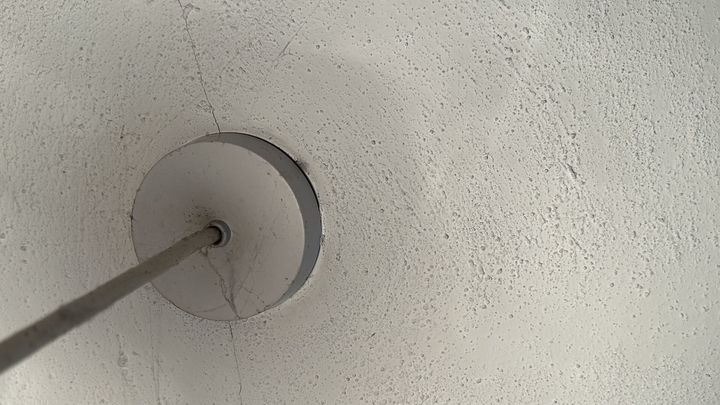
And then it's normal walls, and then into this window again the weird painted on lumps.
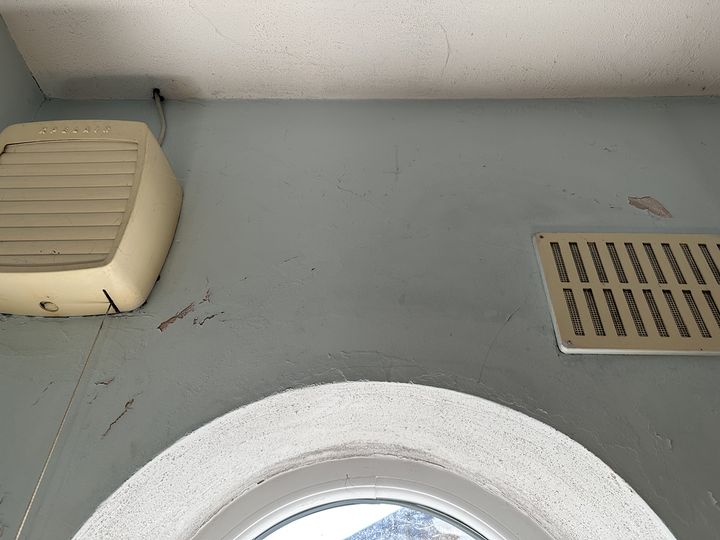
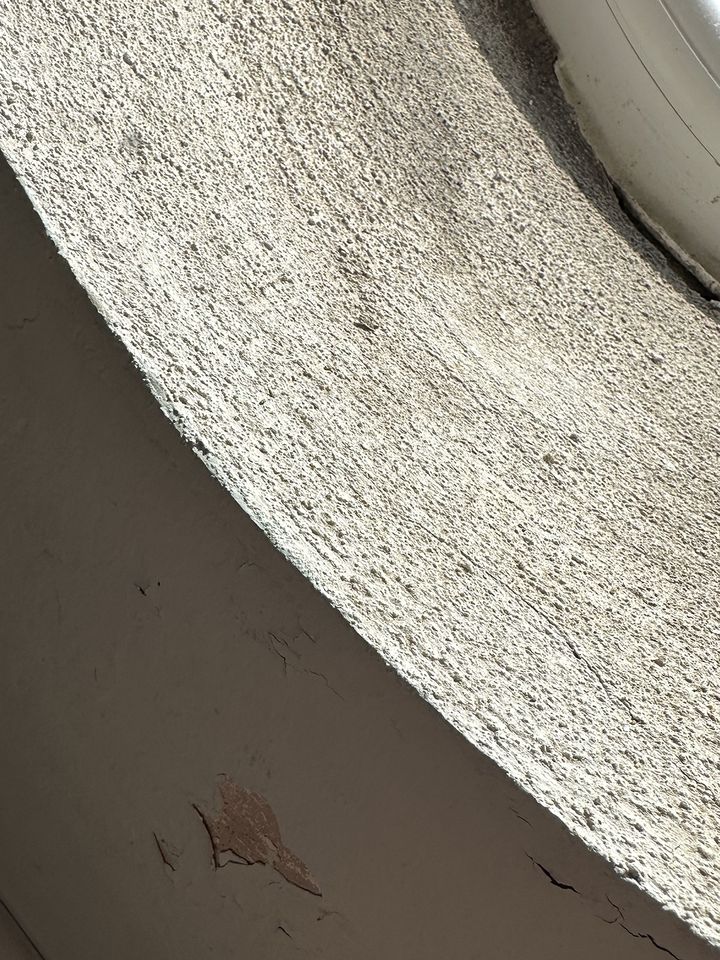
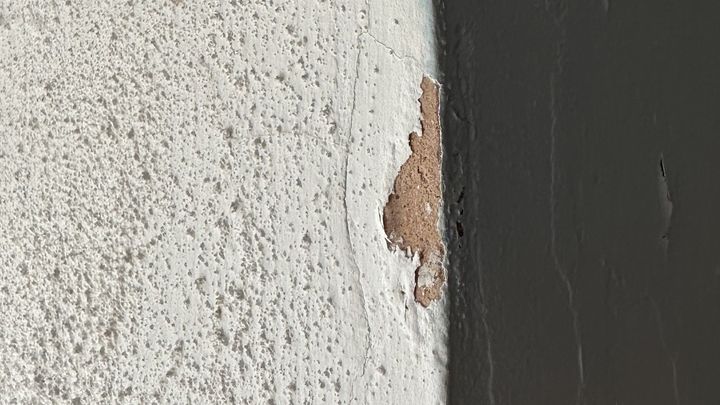
I'm probably going to pay for a sample test of it just to be sure. But I'm curious if this was some kind of 'finish' from that era for laundry type rooms?
The ceiling height is near identical to the next door new anexxe kitchen (within 2mm) which has downlighters and appears to have had a brand new ceiling/plasterboard (need to inspect from above, but that's another story)
In the hall out the the other laundry room door, the ceiling is equal height and has nice coving and nice textured wall-papered ceiling right around the rest of the bungalow proper.
Is there a good way to tell? I've read the popcorn finish has like crispy lumps that you can 'pop' rather than solid paint, so was going to have a go at popping one with the Henry sucking away and the body outside the house.
On other random matters.
This high quality topping off of the cold feed had me questioning the stop tap on this fitting, which did later reveal to be leaking via the tap, and also weeping ever so slightly via the olive onto the copper.

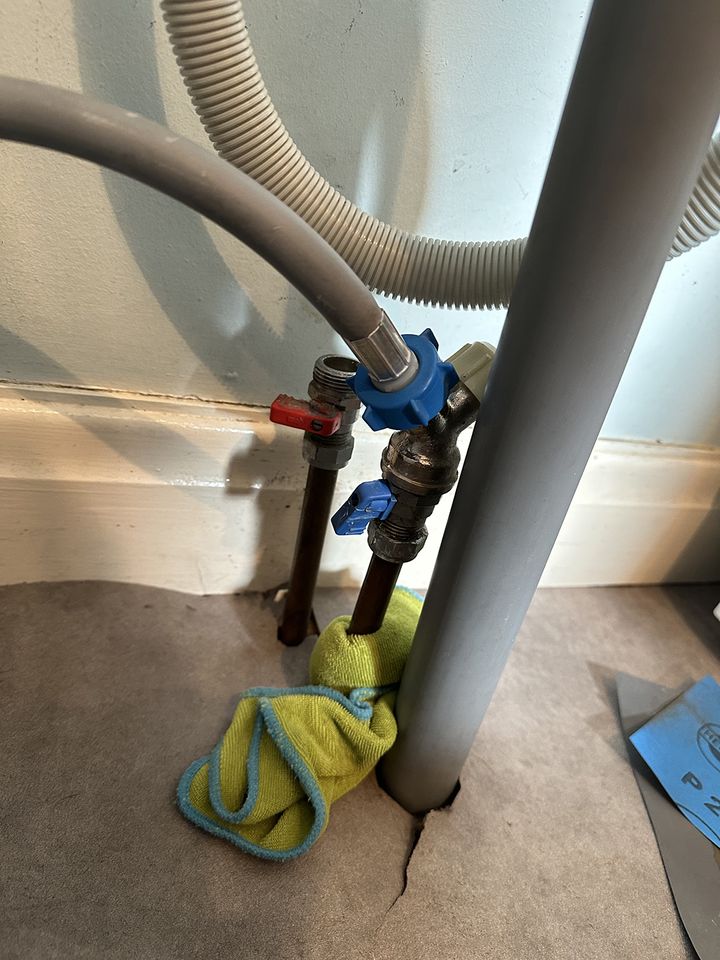 |https://forums-images.pistonheads.com/31869/202506095400088[/url]
|https://forums-images.pistonheads.com/31869/202506095400088[/url]
The kitchen stop tap is siezed solid, and the one in the garage was siezed but came loose, but is weeping very slightly after using once to get the washer connected.
I felt it best to not tamper with any of it again until I have a working and reliable garage stop tap to lean on, so I think I'll use a plumber for that task.
The current plan (sans the sink bits, need to decide what to do at that side)

Not sure exactly of the date but the planning permission suggests late 78 and I assume built in 79.
I have a 1986 aerial photograph and you can tell it's largely remained the same. A big 5x6m garage, attached anexxe with a new ensuite and kitchen, and an ok bedroom and small lounge, and then four good bedrooms, kitchen, dining room, laundry, big lounge, etc.
It feels like it was a quality build all-round, with fixtures and fittings and a level of build quality I've not really seen before except from people really going a bit above and beyond, which is what ultimately led us to take a punt with it.
This thread will probably reveal more as I hit problems and need advice, or just serve as an interesting journal of the weird and wonderful stuff I find in a build of this era.
One big worry with this place was this single room, the utility/laundry. The ceiling looked weird and we instantly though artex/asbestos... the round window looked weird, and it's the worst room in the house.
Even the estate agent removed the picture of it after it'd been on the market a while as it looked so bad

Mangaged to get the washer and dryer in, but for now, the ceiling.
I've read a lot about asbestos and I really have no idea what this finish is. Every other room in the house is either flat painted plasterboard or textured wall-papered plasterboard, all in good condition and I think largely original.
This room splits the anexxe from the main bungalow, and feels like it's always been a laundry with the little round window and sink.
It seems to have a flow to it around this light pendant, like it's painted on.
Is this the 'popcorn' finish that often contains asbestos?
And then it's normal walls, and then into this window again the weird painted on lumps.
I'm probably going to pay for a sample test of it just to be sure. But I'm curious if this was some kind of 'finish' from that era for laundry type rooms?
The ceiling height is near identical to the next door new anexxe kitchen (within 2mm) which has downlighters and appears to have had a brand new ceiling/plasterboard (need to inspect from above, but that's another story)
In the hall out the the other laundry room door, the ceiling is equal height and has nice coving and nice textured wall-papered ceiling right around the rest of the bungalow proper.
Is there a good way to tell? I've read the popcorn finish has like crispy lumps that you can 'pop' rather than solid paint, so was going to have a go at popping one with the Henry sucking away and the body outside the house.
On other random matters.
This high quality topping off of the cold feed had me questioning the stop tap on this fitting, which did later reveal to be leaking via the tap, and also weeping ever so slightly via the olive onto the copper.
The kitchen stop tap is siezed solid, and the one in the garage was siezed but came loose, but is weeping very slightly after using once to get the washer connected.
I felt it best to not tamper with any of it again until I have a working and reliable garage stop tap to lean on, so I think I'll use a plumber for that task.
The current plan (sans the sink bits, need to decide what to do at that side)
If the ceiling artex does contain asbestos, it's worth noting this is a low-risk material. The asbestos content is generally low and the fibres are well bound. The best solution is generally to overboard and skim, which is quite likely what has been done in the rest of your house.
With a late '70s bungalow, I'd be very aware of the possible presence of asbestos everywhere though. You say you've got a garage - it's highly likely the ceiling is AIB - a dangerous type of asbestos which was phased out in the early 1980s (I think). It could also be in your floors, behind your electricity meter, in pipework boxing, anywhere really.
You're fine to leave as it is and it should be perfectly safe if in good condition, but if you're knocking stuff about (which seems likely) a refurbishment asbestos survey is money well spent imo.
You can't tell visually btw whether something is 'hot' for asbestos. But I think it was phased out of artex about 1985, so it's highly likely to contain. 1960-1980 was 'peak asbestos'.
Looking forward to updates!
With a late '70s bungalow, I'd be very aware of the possible presence of asbestos everywhere though. You say you've got a garage - it's highly likely the ceiling is AIB - a dangerous type of asbestos which was phased out in the early 1980s (I think). It could also be in your floors, behind your electricity meter, in pipework boxing, anywhere really.
You're fine to leave as it is and it should be perfectly safe if in good condition, but if you're knocking stuff about (which seems likely) a refurbishment asbestos survey is money well spent imo.
You can't tell visually btw whether something is 'hot' for asbestos. But I think it was phased out of artex about 1985, so it's highly likely to contain. 1960-1980 was 'peak asbestos'.
Looking forward to updates!
Edited by LR90 on Monday 9th June 17:26
Mr Whippy said:
We've just bought a late 70s bungalow. It's a bit of a project, but hopefully mostly it can be a heavy DIY with trades when really required type job.
Not sure exactly of the date but the planning permission suggests late 78 and I assume built in 79.
Best of luck with the work. I m in the process of buying a late 50s bungalow, which needs quite a bit of updating and renovating, so will be interested to hear how you get on.Not sure exactly of the date but the planning permission suggests late 78 and I assume built in 79.
My ex insisted upon ripping out every wall and ceiling in our current place, as there were bits of asbestos, as with most 30s houses. As I understand it, it s mostly not an issue unless you re smashing out walls, though it sounds like you may be doing some of that.
Think asbestos removal companies normally test a load of different locations when checking for stos, and am sure they d want to investigate the different wall surfaces of the main house, annexe and garage parts to gauge any problem locations.
Hi there
It looks like Artex as per the other responses, and if you want to take it down it's a pretty simple job for an asbestos removal company - the other benefit of getting them in is that they need to leave the room clean and remove all the dust, so they take away the ceiling and don't leave any mess!
We worked through a 70s town-house with Artex on every ceiling and it wasn't too bad in terms of hassle, and whilst the ceiling removal was definately more expensive than a regular ceiling in the grand scheme of things it wasn't unreasonable and meant we didn't need to worry about it.
I wouldn't use a Henry if you are peeling bits off as that has the potential to spread the dust more widely, at least that's my understanding. Basically if you leave it undisturbed it's fine, but creating dust by sanding or breaking it up is where the problem liies. There are some good guides on the textured ceiling removal here if you haven't already seen them:
https://www.hse.gov.uk/asbestos/essentials/index.h...
Good luck with it!
It looks like Artex as per the other responses, and if you want to take it down it's a pretty simple job for an asbestos removal company - the other benefit of getting them in is that they need to leave the room clean and remove all the dust, so they take away the ceiling and don't leave any mess!
We worked through a 70s town-house with Artex on every ceiling and it wasn't too bad in terms of hassle, and whilst the ceiling removal was definately more expensive than a regular ceiling in the grand scheme of things it wasn't unreasonable and meant we didn't need to worry about it.
I wouldn't use a Henry if you are peeling bits off as that has the potential to spread the dust more widely, at least that's my understanding. Basically if you leave it undisturbed it's fine, but creating dust by sanding or breaking it up is where the problem liies. There are some good guides on the textured ceiling removal here if you haven't already seen them:
https://www.hse.gov.uk/asbestos/essentials/index.h...
Good luck with it!
My refurb project bungalow was built at the same sort of time.
All ceilings were done in a similar artex finish - nothing in the place was plastered and I think that's why it was used - low skill to apply. The walls were just boarded and filled on the joints.
The floor was also tiled, and those tiles and the adhesive were highly likely to contain Chrysotile asbestos. As were the soffits, undercloaks etc and the boiler cupboard. Be careful when drilling, digging and changing things - get samples taken and tested.
All ceilings were done in a similar artex finish - nothing in the place was plastered and I think that's why it was used - low skill to apply. The walls were just boarded and filled on the joints.
The floor was also tiled, and those tiles and the adhesive were highly likely to contain Chrysotile asbestos. As were the soffits, undercloaks etc and the boiler cupboard. Be careful when drilling, digging and changing things - get samples taken and tested.
Grandad Gaz said:
I'm not sure if it's Artex. It looks a bit too much of a DIY job to me.
My guess would be something along the lines of Polytex.
Wow thanks for the thoughts everyone, lots to think (worry) about!My guess would be something along the lines of Polytex.
I've been going around the house looking at all nooks and crannies for evidence of artex elsewhere and I can't find any.
For instance, most rooms with wallpaper ceilings have something else in them, like fitted wooden wardrobes, and inside them the ceiling is smooth, and the wall paper terminates with a dip at the edge behind the wood, suggesting the paper was over this smooth surface.
The ceiling is then clearly painted because in these smooth areas it's a paint layer (cracks or scuffs evident), and behind that is plaster (not paper on the plaster boards)
I did have an 'oh no' moment in the main bedroom which has a wall and a half of wooden panelling, apparently vogue in the 75-85 period. Down a narrow gap I saw swirls, but then noticed elsewhere in a wardrobe the same swirl pattern which is wallpaper (with 2mm ish polystyrene backing?) over the plaster/plasterboard.
I was having a good look around the old airing cupboard area as apparently AIB instead of conventional plasterboard could be popular in such areas. I was also conscious that people were mentioning 'cheap' as the prevailing paradigm and just wall papering over plasterboards, but after lots of looking even the plasterboard in the airing cupboard (back-side wall above the door) has been plasterboarded, with the outer paper visible, then plaster over that, then paint over that.
Assuming the plasterboard itself doesn't have asbestos in it (encased and likely low percentage as the boards feel very dense and unyielding), then it doesn't seem like they went for cheap and cheerful finish even in a place I had to contort myself to get into!
I was a bit suspicious about a window opening cavity covering, under the wall paper there is clearly the metal beading at the corner, but about 2" back along the opening towards the frame (probably still over the internal leaf) was a grey hard substance, almost felt like a concrete block but pretty smooth... I had a good scratch with my fingernail but it felt solid. No idea what/how these were done.
It did have new double glazing about 10 years ago though so assume whoever did it all might know something, but clearly worked around it over a bunch of visits to change about 10-15 windows etc.
I have a chap coming on Friday who's had a career doing surveys and testing for asbestos. I'l let him go wild and take loads of samples and then I can just go renovating where it's clear or fix where it's not... as almost every room could do with some work which will necessitate drilling, wiring ducting, ripping stuff out/up etc.
On the garage, fortunately there is no AIB 'roofing'
The floor is concrete, the walls are block and brick. The meter boxes for gas and electric are seemingly original and white like modern units (visible in a 1986 aerial photo of the property), but are on the outside of the garage wall.
The felt looks a bit iffy along parts of the edges, one area in particular with a broken sideways thin bit (forget the name
 ). I've read about bitumen with asbestos in it, and this looks like bitumen and fabric for felt... so likely I'll get a sample of this cut off to have checked.
). I've read about bitumen with asbestos in it, and this looks like bitumen and fabric for felt... so likely I'll get a sample of this cut off to have checked.Also not sure on the tiles proper, possibly an asbestos type from the era? The new one further up the roof looks quite different in finish. Again I'll find a broken off bit to be sampled I think.
The main house roof and felt is the same as far as I can tell, and the felt is similarly damaged in one area on the gable end that meets the garage, with the tiles exposed into the loft space, so probably valuable to know if these pose any risk so I can at least treat the loft space accordingly.
The previous owner kindly left some units/bits for me in the garage, but I think this was half cover for just leaving lots of stuff he couldn't be arsed taking/finding a skip for

There are actually some nice interesting random tools and stuff, but I think mostly this is just going to be totally emptied into a skip, new wall plugs/LED lights fitted, and then a bunch of IKEA Bror bits for now to put my stuff in.
Then I want to keep it mildy warmed, dehumidifed, and I'll see how flat the floor is and painting it etc.
I think it's a 4.9m wide x 5.9m long garage (last time I measured), and the front door aperture is offset 70cm from the wall at one side, so a decent size for a full wall of 60cm deep units front to back, and still leaving tons of space for a single car (possibly two at a squeeze)
It'll be nice to be able to jack the car up on a flat indoor area, and have room all around it to do jobs with the tools easily accessible.
Wow, I just signed up with British Gas (two weeks after moving in, previous supplier at last place and here, so was quite handy)
Gas seemed pretty reasonable using the previous owner's units, and used BGs current fix for £1,900 a year ish.
But electricity, I took my last 2 weeks use which was roughly in line with our old place, which I think was high given usage, WFH, kids etc, so went with that for £1,400 a year ish.
The previous owners were using £3,073 a year equivalent on the current fix rate!
Given the 70mm loft insulation, vs the supposed 270mm on EPC, and similar for having all low-energy lighting (seemingly not, half at best), I think I can spend a few quid and massively improve things here.
Just looking at Octopus Agile prices and the cost of a battery to go with my new consumer unit install... seems a no-brainer also.
Gas seemed pretty reasonable using the previous owner's units, and used BGs current fix for £1,900 a year ish.
But electricity, I took my last 2 weeks use which was roughly in line with our old place, which I think was high given usage, WFH, kids etc, so went with that for £1,400 a year ish.
The previous owners were using £3,073 a year equivalent on the current fix rate!
Given the 70mm loft insulation, vs the supposed 270mm on EPC, and similar for having all low-energy lighting (seemingly not, half at best), I think I can spend a few quid and massively improve things here.
Just looking at Octopus Agile prices and the cost of a battery to go with my new consumer unit install... seems a no-brainer also.
Grandad Gaz said:
I'm not sure if it's Artex. It looks a bit too much of a DIY job to me.
My guess would be something along the lines of Polytex.
Back in the early 80s, I had a student part time job in a DIY store.My guess would be something along the lines of Polytex.
There were lots of 'lumpy paint in a bucket' products.
It doesn't look like Artex, which is a smooth fluid when it goes on , the texture being applied with combs, rollers or a sponge or something for a stippled effect.
Gassing Station | Homes, Gardens and DIY | Top of Page | What's New | My Stuff



